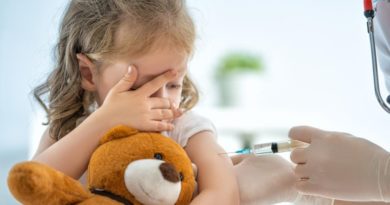Half-baked Conspiracy Theories Cloud Those Refusing the COVID Vaccine

Many years ago as a young first time father, I stood patiently in line at the pediatrician’s office cradling my infant son in my arms waiting for him to receive a vaccine dose that would protect him from polio, a deeply frightening disease that struck mainly the young and healthy, leaving many paralyzed, unable to breathe without mechanical assistance while taking the lives of many others.
The waiting room was filled with men and women just like me, nervous with anxiety visible on our faces, acutely aware that the disease struck indiscriminately principally in the summer months and was incurable.
Those of us who grew up in our small Pennsylvania hometown had lived through polio epidemics in the past and we all knew of families devastated by their youngsters falling victim to the disease and condemned to suffer through the aftereffects, some confined to wheelchairs and leaving others with lifelong disabilities.
Even the non-medical textbook description it was given back then — infantile paralysis — was a graphic acknowledgment that its devastation fell disproportionately on the young population.
The term “iron lung” entered the vocabulary, a terrifying name for a chamber like apparatus enclosing polio sufferers and breathing for them. For some, their damaged lungs would never regain function.
Each summer, community swimming pools and theaters were closed in the belief they were origin points for the disease.
When a vaccine was developed and approved in 1955, the nation breathed a sigh of relief that, at long last, an end to the heartbreak and pain of losing a child to polio was at hand.
Recalling that time, the sense of dread of the approaching summer months bubbled up in my mind as the COVID-19 pandemic plunged the country into its most serious public health crisis in a century.
It was accompanied by a disbelief that millions of people refused to accept vaccination and many continue to stubbornly do so.
Why is it necessary to offer enticements— lottery tickets, vacation trips, bonuses and free food and beverages— to convince people that a needle jab in the arm can spare them from serious illness and even death?
Is not the fear of an incurable, highly contagious and potentially fatal ailment sufficient persuasion?
The vaccine is free, convenient and nearly 100 percent effective. When I first came across the term “vaccine hesitancy” in the media, it struck me as denying the existence or lethality of the COVID pathogen, convincing oneself it isn’t serious, or gambling it’s no more debilitating than the common cold.
What if I’d been captured by “vaccine hesitancy” in that pediatrician’s office those many years ago?
What if I’d left my infant son without protection from a disease that could cripple him or cut his life short?
What if I’d embraced a “take my chances” approach to the vaccine? And, what if I’d lost?
It is, perhaps, a generational issue, a product of an environment in which faith and confidence people of my era held in government has been replaced by mistrust and alienation.
To many, it seems, official government pronouncements are untrustworthy, a “we’ve been lied to so often” belief that has become so embedded that it overrides logic and medical evidence.
It is, for instance, indisputable that dramatic declines in infections, hospitalizations and deaths correlates to the increase in vaccination rates.
Other factors — business and school closures, restrictions on gatherings, mask wearing — contributed to the decline but without a vaccine the pandemic would continue to rage on.
It is not my intention to dismiss those who’ve refused a vaccination; I respect the views and beliefs of those individuals. Unfortunately, they’ve been obscured by half-baked conspiracy theories, political posturing and assigning blame to others.
Religious beliefs which reject vaccinations and those who suffer medical conditions which cannot tolerate a vaccine, for instance, are not to be ridiculed or derided. Lumping them in with so-called anti-vaxxers is a sign of callous disrespect.
Comparisons are not always perfect, seldom fitting neatly into compartments. Comparing polio with the COVID-19 pandemic is not perfect, either.
For example, COVID has infected nearly 900,000 New Jerseyans since March of 2020 and proved fatal to more than 27,000. 52.5 percent of the state’s population has been fully vaccinated.
Nationally, the numbers are staggering: 34 million infected Americans and 600,000 deaths. 44.2 percent of the nation’s population has been fully vaccinated.
The most severe national polio epidemic occurred in 1952, striking down 58,000 and killing 3,000. It struck fear in the country’s heart, though, which may be difficult to understand given the disparity in severity with COVID.
It was genuine and real, leading me and my peers who were just entering that part of our adult lives that included starting a family to stand in line in a doctor’s office holding our sons and daughters.
It was all worth it. There hasn’t been a recorded case of polio in the United States since 1979.
Carl Golden is a senior contributing analyst with the William J. Hughes Center for Public Policy at Stockton University.
(Visited 135 times, 135 visits today)


